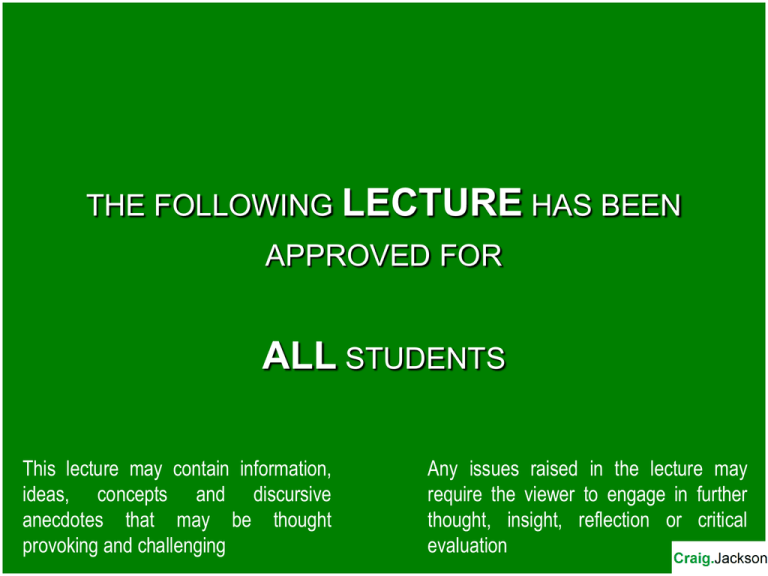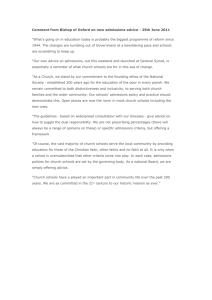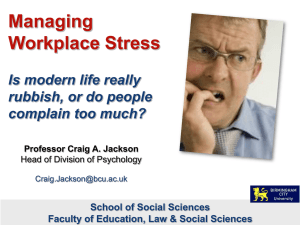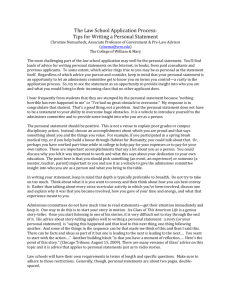stress - Faculty of Health, Education and Life Sciences
advertisement

THE FOLLOWING LECTURE HAS BEEN APPROVED FOR ALL STUDENTS This lecture may contain information, ideas, concepts and discursive anecdotes that may be thought provoking and challenging Any issues raised in the lecture may require the viewer to engage in further thought, insight, reflection or critical evaluation Workplace Stress Is modern life really rubbish? Are we just moaning too much? Professor Craig Jackson Prof. Occupational Health Psychology Head of Psychology BCU craig.jackson@bcu.ac.uk Stress – The Basics Stress is not a useful concept because: Definition problems Not just at workplace Individual response Work-life Balance Control Demand Personality Cause of many secondary health problems Loose diagnostic criteria Too many triggers Too many responses Too many effect modifiers Used too casually Fashionable Positive perceptions Not reliably measured Workplace Hazards – current status Shiftworking: 1 in 5 employed likely to increase with growth Fatigue Somatic symptoms Long hours: Psychosocial: Physical: >48 hours per week Fallen due to EWTD Still > most of Europe Sleep MSDs 5 mill employees perceive effects 13 mill working days lost Mundane occupations suffer Chronic stress more problematic Depression Noise Dust Chemical Vibration Depression technical changes monitoring OELs Cardiovascular Accidents QoL France Telecom Case Privatised in 1998 40,000 jobs gone since 1998 186,000 employees 45% of those outside France Used to be public sector employer new working conditions modernisation cultural & organisational changes needed internal job transfers 4.3% fall in profits in 1Q of 2009 182 million customers in 5 continents France Telecom Case France Telecom Case Between Feb 2008 – Sep 2009 23 staff committed suicide • 9th Sept: 49 yr old male employee stabbed himself in meeting – told he would be undergoing internal job transfer • 11th Sep: 32 yr old female employee leapt to death from office window • 14th Sep 53 yr old senior manager overdosed • 1st Oct: 51yr old male employee jumped from road bridge – note blamed work “atmosphere” French suicide rate: 26.4 per 100,000 male deaths 9.2 per 100,000 female deaths 17.8 per 100,000 all deaths France Telecom’s Defence France Telecom’s two-point defence: 1) “There were 28 suicides in the company in 2000, so 23 suicides over 17 months is actually an improvement and not evidence of an epidemic” 2) “Most suicides caused by personal problems not professional ones” France Telecom Case Oct 2009 Deputy CEO Louis-Pierre Wenes (second in command) resigns CEO Didier Lombard – vowed to end the “Spiral of death” Phone helpline Counselling Suspending job transfers French Labour Minister, Xavier Darcos wants: 2,500 biggest companies to plan “anti-stress” strategies Plan it with Unions Govt has 27% stake in FT Health & Happiness now on “National Agenda” in France Foxconn and the iPad Manufacturing giant in China Renowned for efficiency – 300,000 employees Laptops, mobiles - Nokia, Apple, Dell HP 13 suicide attempts since Jan 2010 – 10 deaths Foxconn and the iPad Compensation for families in poverty Working conditions – long shifts, rigid, Oppressive, poor pay Company asked workers to sign a letter promising not to kill themselves (now withdrawn) Building giant safety net to prevent jumpers from Dorms and Workshops Hiring counsellors and Buddhist monks Work has not really changed . . . . . . Attitudes have changed When did this happen? NOTICE OUR STAFF HAVE THE RIGHT TO WORK IN AN ENVIRONMENT FREE FROM VIOLENCE We will prosecute anyone found abusing or threatening employees * * This will not affect your treatment Misperceptions of workplaces UK Climate of: over-perception of danger stress being unavoidable wanting too much in return Common Popular Headlines High Profile Stress Cases Isaac Blake VS Ragdoll Productions 2008 “Cold-blooded murder of English Justice” Johnstone vs Bloomsbury H.A Doctor Walker vs Northumberland C.C. Social Worker Jones vs Birmingham C.C Teacher Hurley vs Gwent Constabulary Police officer Fearon vs Martin Burglar Armstrong vs Home Office Prison officer High Profile Case 1 Andrew Hurley vs Gwent Constabulary Armed Response Unit First on scene of armed robbery – Three armed offenders at bank Hurley shot 1. all 3 in custody Won a commendation for the job Resultant stress & depression Left job 5 months later Wanted £250,000 for loss of earnings and pension rights Claimed offered no post-intervention counselling Kept isolated for an hour after event – blood on hands Tribunal heard evidence from Gwent Co. that counselling was offered 2 months after the shooting Gwent Co. Claimed Hurley turned down initial offers of counselling Court of Appeal Guidelines (16 points) Individuals who do not notify their employer of any problems are less likely to to succeed in claiming compensation Employers entitled to assume employee can withstand normal job-pressure unless any vulnerability or problem is known No occupations should be regarded as intrinsically dangerous to mental health Employers offering counselling and access to treatment unlikely to be found in breach of duty Employers not in breach of duty if only option is to demote or fire employee, if a willing worker continues in same job Necessary to identify all steps employers (could) have taken before finding them in breach Traditional model of Disease Development Pathogen Modifiers Lifestyle Individual susceptibility Disease (pathology) Dominance of the biopsychosocial model Mainstream in last 15 years Hazard Illness (well-being) Psychosocial Factors Attitudes Behaviour Quality of Life Rise of the worker as a “psychological entity” The Biopsychosocial Model – works on all levels “Everything is bad for us these days…” Top 5 Workplace Health Problems 1. Hearing loss NIHL, TTS, Exposure 2. Respiratory problems Asbestosis, Carbon Black, Recycling 3. Skin problems Hairdressers, Health care, Engineering 4. Mental health Stress, Anxiety, Uncertainty 5. Musculoskeletal disorders Desk workers, Cleaners, Drivers Potential Health Risks 3x Cardiovascular problems “High Demand Low Control” 3x Back pain 2x Substance abuse 2-3x Injuries 5x Certain cancers 2-3x Conflicts 2-3x Infections 2-3x Mental health problems Shain & Kramer 2004 “High Effort Low Reward” Futility of Some Stress Research “One evening we had an almost inaudible talk from…..the BBC staff doctor who told us how to recognise stress in our staff: the body sits slumped, with the head shrunk between the shoulders. At least I think that is what he said. He was difficult to hear as we were all sitting slumped with our heads shrunk between our shoulders” Frank Muir in A Kentish Lad Responses to Stress Physiological changes • Heart rate • Blood pressure • Biochemical > adrenaline > cortisol > serotonin > free histamine Psychological changes Anxiety Depression Tension Tired Apathy Apprehension Alienation Resentment Confidence Aggression Withdrawal Restlessness Indecision Sleeping problems Concentration Worry Legal Aspects “Personal Injury” Any impairment or any disease of a person’s physical or mental condition 1974 Health and Safety at Work Act “Assessments of risks of activities associated with potential hazards” 1992 Management of Health & Safety at Work Regulations Big stress cases 1. Johnstone vs 2. Walker vs 3. Jones vs 4. Hurley vs 5. Fearon vs 6. Armstrong vs Bloomsbury H.A Northumberland C.C. Birmingham C.C Gwent Constabulary Martin Home Office Doctor Social Worker Teacher Police officer Burglar Prison warder High Profile Case 2 Isaac Blake VS Ragdoll Productions 2008 “Cold-blooded murder of English Justice” Tombliboo Homophobia , Bullying, Harassment Faulty animatronics - Painful work – hip joints Lost 4 / 5 claims Awarded £2000 for being called a “faggot” twice High Profile Case 3 Armstrong vs Home Office 1996 PO while west on remand Close escort duties 31 day trial Volunteered for escort Claims was forced to covertly gather evidence SA - stress and depression High Profile Case 4 Psychological interventions can work Cromwell Street Murders John Bennett SIO Team of 40 detectives Sought “Stress Counselling” Proactive Some accepted – others did not Upon retirement . . . What workers expect Reasonable expectations? Financial Achievable ? Advancement Affordable ? Status Respect Perks Education / Training Autonomy Dissatisfied workforce? Aggrieved employees? Unmotivated staff ? Flexibility Pensions Support Security Commuting “Cattle Truck Syndrome” Chronic health problems exacerbated by train travel? Cumulative impact theory Increased B.P, Anxiety, Chronic Heart Conditions Over-crowded trains / buses Straining public transport system Lack of control Commuting “People develop a constant internal anger on crowded trains that they cannot easily displace…an individual's immune system could also be suppressed by stress, making passengers more susceptible to illnesses” Long Working Hours “Workaholism” Japan, South Korea, Indonesia, UK (Karojisatsu) uninterrupted heavy workload heavy physical work excessive demands from irregular overtime and shift work excessive workloads from emotional stress, such as responsibility, transfers, and conflicts • irregular sleep habits • decreases in rest • decrease social time • alcohol abuse • increased smoking • unhealthy diet • neglecting medical checks • breakdown in family life Office Work “Veal – Fattening Crate” * “Small, cramped office workstations built of fabric covered disassemblable wall partitions and inhabited by junior staff members. Named after the small pre-slaughter cubicles used by the cattle industry” Douglas Coupland in Life After God (being ironic) *Do farm animals get better conditions than some workers? Stress “Golden Age of Stress” Everyone is Stressed BBCi - “Stress” = 16,000 finds More people experiencing more stress Greater demands from employers People working longer hours 24 / 7 / 365 society 21st Century Satanic Mills 21st Century Satanic Mills Psychosocial factors at the core of ill-health Individual vulnerability MSDs Personality type Experience Stress Distress Somatics Learned behaviours Mental Health Will workers take responsibility for their ill-health? Recall ADT? Stress Definitions #1 A. Stress occurs when demands exist which are outside a person’s capacity for meeting those demands B. Stress is a response to the presence of psychosocial hazards in the workplace C. Stress is the reaction people have when they feel they cannot cope with the pressures or demands placed upon them Over-simplistic definitions ! Stress Definitions #2 Stress is the disparity between what needs to be done (required) and what can be done (actual) required Problems actual demands are not static required actual required actual abilities are not static how to quantify disparity meaningfulness of any quantification individual modification So who has the “bad” jobs? EXTREMELY STRESSFUL Police Fire Ambulance Prison VERY STRESSFUL Civil pilots Media Health care (non-emergency) Performers Social work ABOVE AVERAGE STRESS Marketing Publishing Retail Catering Printing Transport Teaching Mining Nursing Construction HOW MUCH FAITH CAN BE PUT INTO BROAD CATEGORIES? Cooper 1988 Don’t Mention the “S”-Word ! ! ! Stress Looks like a flaming deamon Sounds like an eagle squaking Tastes like a burnt sausage Smells like sour milk Feels like stroking a hedgchog Stress is when mum says NO!!!!! by Andrew (aged 10) Year 5 Potley Hill Primary School “Stress-Bunny” The curse of the Corpus Linguistic Common Parlance “Stress-Junkie” Stress is Nothing New World Wars I and II Where was stress? Dud shell manufacture Some Stress is good Keeps one alive performance Keeps one alert Evolutionary perspective: Too little stress = extinction Too much stress = extinction Balance stress = evolution Pressure is good - - Stress is bad stress Stress Statistics 1995: Labour Force Survey 515,000 reported work-related stress 250,000 attributions of physical symptoms 30% increase in reports since 1990 1996: Institute of Management 270,000 daily absences for stress £10.2 Billion cumulative annual cost (sick pay, lost production, treatment) 2002: UK Health and Safety Executive 265,000 new “cases” in 2001 2000: Evans et al. Scottish heart attack deaths higher on Mondays 2004: UK Health and Safety Executive 13,000,000 working days lost / year £12 Billion cost Admissions and World Cup 1998 Examine hospital admissions for range of diagnoses on days surrounding England's 1998 World Cup football matches Hospital admissions obtained from English hospital episode statistics Pop. Aged 15 – 64 years Admissions for • Acute MI • Stroke • Deliberate self harm • Road traffic injuries On match day and 5 days after match day Compared with admissions at the same time in 1997 and 1998 Carroll, D et al. 2002 Admissions and World Cup 1998 England's matches in the 1998 World Cup 15 June 22 June 26 June 30 June (England 2, Tunisia 0) (Romania 2, England 1) (Colombia 0, England 2) (Argentina 2, England 2) win lost win lost: penalties 4-2 Extracted hospital admissions data for acute myocardial infarction, stroke, deliberate self harm, and road traffic injuries among men and women aged 15 to 64 Games all took place in late evening Examined the same associations using only the two days after the match omitting the day of the match as the exposed condition Admissions and World Cup 1998 During the period of England's World Cup matches (15 June to 1 July) 81,433 emergency admissions occurred: 1348 662 856 3308 Day of match 1 day after 2 days after 3 days after 4 days after 5 days after (2%) for myocardial infarction (1%) for stroke (1%) for road traffic injury (4%) for deliberate self harm observed / expected admissions 91 / 72 88 / 72 91 / 71 76 / 74 71 / 74 83 / 72 actual – expected admissions 19 16 20 2 3 11 ARR 1.25 (0.99 to 1.57) 1.21 (0.96 to 1.57) 1.27 (1.01 to 1.61) 0.99 (0.77 to 1.27) 0.92 (0.71 to 1.19) 1.13 (0.89 to 1.43) Admissions and World Cup 1998 Admission diagnosis Within 2 days of win Within 2 days of 1-2 loss Within 2 days of loss on penalty P value M.I 0.99 0.89 - 1.11 0.91 0.78 - 1.07 1.25 1.08 - 1.44 0.007 Stroke 0.87 0.74 - 1.03 0.97 0.79 - 1.19 1.00 0.82 - 1.23 0.42 RTA 0.99 0.85 - 1.14 0.96 0.79 - 1.17 0.85 0.69 - 1.05 0.51 DSH 1.08 1.00 - 1.16 1.01 0.91 - 1.12 1.05 0.95 - 1.16 0.26 •Periods after a win (Tunisia, Columbia) and 1st first loss (Romania) were not associated with increased admissions • On match day, and two days after match against Argentina with a penalty shoot-out, admissions for acute MI increased by 25%. • No increases in admission were seen for any of the other diagnoses. Admissions and World Cup 1998 Major environmental events, whether physical catastrophes or cultural disappointments, are capable of triggering myocardial infarction. If the triggering hypothesis is true, preventive efforts should consider strategies for dealing with the effects of acute physical and psychosocial upheavals. “Perhaps the national lottery or even the penalty shoot-out should be abandoned on public health grounds.” Limitations: Harvesting effect? Reporting tendency? Sudden deaths? “Oh Give Over!” This has all gone too far The Anti-Stress Backlash “Meddling Psychologists” Iatrogenesis • Induced inadvertently by the medical treatment or procedures or activity, examination, manner or discussion of a physician. • The term is now applied to any adverse condition in a patient occurring as the result of treatment by a physician or surgeon, (e.g. acquired infections) • A disease produced as a consequence of medical or surgical treatment. Being cynical . . . Common Coping Styles Adaptive coping Seek those with similar experiences Stick to a plan of action Day to day basis Seek information Confront issue Support seeking Change situation LONG TERM SOLUTION Maladaptive coping Withdraw from people in general Avoidance Deny what has happened Consumption Drink, eat, smoke to relieve tension Denial SHORT TERM SOLUTION The Self-Loathing and Self-Improvement Culture The age of the medical / health professional life-coach-guru-reality-tv-show We’re all defective and we need to change ourselves “I like money” “I like money too” “Not as much as I do” Individual Variability / Vulnerability Differing Attitudes & Differing perceptions Natural differences Complex reasons Experience Personality Learned behaviours Stress is associated directly with workplaces BUT is also mediated by individual differences No universal profile of what will certainly constitute stressful situations Vulnerable People Important to be aware of vulnerable individuals and groups Associated with socio-economic, cultural or demographic status Females Immigrant workers Disabled Excluded groups Ethnic minorities Any group by definition which is un-empowered Personality – although some of this is spurious! “Type A” (uptight, goal oriented) likelihood of stress-illness and CHD (?) “Type C” (high anxiety) likelihood of Cancer (?) “Type D” (negative affectivity, emotional inhibition) likelihood of CHD (?) “External” locus of control poorer at handling stress “Hardiness” greater resistance and operability Personality Hey. On way Hi Claire. Are home. Left you around lecture earlyand do cosyou feelfancy like a crap. Next time! brew? A good sign or a bad sign? Personality type Optimism vs Pessimism Negative Affectivity Hardiness Historical Errors of Distress-Related-Ill Health Historically, distress was “blamed” for many ills Now we know better… CHD Cholera Pellagra Beri Beri Asthma Down’s syndrome Scurvy Yellow fever Typhoid Peptic ulcer Sir William Beaumont 1832 All believed to be caused by “stress” or “distress” at one time or another Puts “blame” for illness on the person Acute Stress and Chronic Stress Common After-effects Leave behind Life threatening One-off Ever-present By proxy Post Traumatic Stress Disorder (PTSD) Response to specific traumatic / extreme event DSM IV Diagnostic condition & ICD-10 Diagnostic condition 1. Experience intense fear 2. Persistent re-experience 3. Avoidance of associations 4. Persistent increased arousal since event 5. Flashbacks Associated most with Disasters and Warfare Not new - 6th Century BC Every conflict since American Civil War in 1863 A COMPLETELY POLITICALLY MOTIVATED DIAGNOSIS “Shell-Shock” “Battle fatigue” “Combat Syndrome” NOT GULF WAR SYNDROME Psychosocial Hazards • Commonplace consideration in last 5 years • Not straightforward • All workplaces have potential to expose workers to psychosocial hazards • All social relationships have potential for stress • Little relation between stress incidents and occupational status • Stress-Boom in last 3 years – VERY BIG INDUSTRY • Intolerance of work in environments deemed psychologically stressful “suffering from” & “recognising stress” rapidly increasing issues Acute Hazards Work characteristics 1. Potential for violence Accident & Emergency Services 2. Peril or Danger Expected Dangerous Conditions 3. Potential for aggression Hazardous conditions 1. Verbal abuse Ordinary Conditions 2. Physical abuse Unpredictable Behaviour / Incident 3. PTSD inducement Chronic Hazards Job content Work overload / underload Hazardous conditions Under utilisation of skills Time pressures Lack of control Work organisation Shift work Working hours Work Culture Communication Change / technology Poor resources No feedback No decision process unsociable long unpredictable too little (home-working) / too much (email) Chronic Hazards (cont) Work role Ambiguity Conflict Advancement structure Insecurity Promotion under and over Low status Poor pay Environment Hazards physical / chemical Home – work interface Conflicting demands Support Domestic problems Commuting Interpersonal Conflict Colleagues Superiors Subordinates Personal Issues Isolation Lack of support Harassment Bullying Violence Chronic Hazards - People Sick Building Syndrome – A once popular theory Air quality Chemical pollutants Air con Ventilation Dust Tobacco Space Crowding Isolation Equipment Printers PC’s Noise Equipment Telephones Others Lighting Artificial Glare Control Job content vdu’s Monotony Overload Organisation Control, communication, feedback Is STRESS the common link with SBS? Karasek’s demand-control model of stress development high Productive, Motivated active job control low strain high strain low passive low high job demands Karasek 1979 Risk of psychological strain and increased illness job demands low high active passive high strain low job control high low strain Karasek 1979 Karasek’s revised demand-control-support model high Productive, Motivated active job control low strain Peer Support high strain low passive low high job demands Karasek 1979 Social Support Heroes & Villains Risk of psychological strain and increased illness Psychological Tests Occupational & clinical odd mix Testing standards blasé attitudes over familiar Administration types open controlled supervised managed agree There is too much pressure to get everything done on time If I have a personal problem, I talk to people about it I often feel drained and tired I get headaches at the end of the day I feel much better at weekends My partner asks me how my day has been Provides… consequences perceptions perceived sources of stress not sure disagree Summary of Occupational Stress Any workplace / person / social interaction Stress is a natural / healthy response Some responses to stress are pathological Worker intolerance Impossible to predict stress reliably – easier to predict intolerance Individual modifiers – personality, behaviour, coping style, perceptual processes Legal obligation clearer than ever Psychosocial hazards unavoidable & intrinsic in some cases Most psychometric stress testing unethical HUMAN CONDITION, NOT A “VARIABLE” Questions Why become stress intolerant? Post-Industrial society? Who benefits from this? Too much personal freedom? Celebrity culture - nobody wants the bad jobs? What happens to stress-prone workers? Who is to blame for being stressed? Who is to blame for being ill? Recommended Reading Carroll D, Davey Smith G, Sheffield D, Shipley MJ, and Marmot MG. Pressor reactions to psychological stress and prediction of future blood pressure: data from the Whitehall II study. BMJ 1995;310:771-775. Chen C, David AS, Nunnerley H, Michell M, Dawson JL, Berry H, Dobbs J, and Fahy T. Adverse life events and breast cancer: case-control study. BMJ 1995; 311: 15271530. Jackson CA and Cox T. Health and well-being of working age people. ESRC Seminar Series. ESRC. London. 2006 Jackson CA. Psychosocial Aspects of the Workplace. In Aw, T.C et al. (eds) Occupational Health Pocket Consultant (fifth edition). Oxford: Blackwell Scientific Publishing; 2006. 191-201 Jackson CA. Psychosocial Hazards. In Smedley, J et al. (eds) Oxford Handbook of Occupational Health. Oxford. Oxford University Press; 2007. 167-179 Recommended Reading Kivimäki M, Leino-Arjas P, Luukkonen R, Riihimäki H, Vahtera J, and Kirjonen J. Work stress and risk of cardiovascular mortality: prospective cohort study of industrial employees. BMJ 2002; 325: 857. Levenstein S. Stress and peptic ulcer: life beyond helicobacter. BMJ 1998; 316: 538541. Shain M and Kramer DM. Health Promotion in the Workplace: Framing the Concept; Reviewing the Evidence. Occupational and Environmental Medicine 2004;61:643-648. Work Stress: The Making of a Modern Epidemic. Michael Fitzpatrick. Open University Press, 2002.






